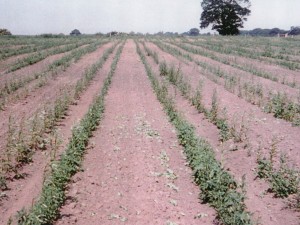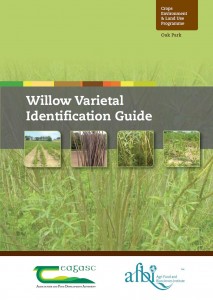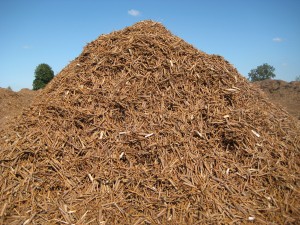10 ways to maximise yield from your short rotation coppice (SRC) crop
It is possible to achieve high yields of over 12 oven dry tonnes per hectare per year from willow grown as short rotation coppice (SRC). To achieve this you need to follow this 10 point plan.
1) Plan early
You really need to start thinking about planting your willow plantation at least 12 months in advance of planting. This will give you the necessary time to make your application to the Energy Crops Scheme (ECS) and prepare your land according to the best practice guidelines. The ECS closes to new applications at the end of August so get cracking with your application now or employ Crops for Energy to do it for you! The process can take 3-4 months and once you get the go ahead you can get started by spraying off weeds and ploughing your land. Unfortunately, most farmers apply late and don’t get a response until late winter by which time they are playing catch up.
2) Know your land
Like all crops willow will do best on the most suitable land. If you plant a crop on your worst land then you will almost certainly get disappointing yields. Willow SRC does best on fertile arable fields with a pH range between 5.5-8.0. They do well on heavy brown earth soils with a high clay content whilst silty and light sandy soils should be avoided. SRC willow needs an annual rainfall of between 600-100mm. Field drains will be affected so plant at least 30 metres from important drains. As with all crops cost effectiveness is achieved from large, regular fields. Smaller, odd shaped fields will increase down time and increase the cost of planting and harvesting.

A clean seed bed is absolutely crucial in the establishment year. Make sure you give your SRC a fighting chance with exemplary weed control.
3) Get on top of weeds
SRC willow is very fast growing but needs minimal competition from weeds in the establishment year is the best yields are going to be achieved. You should be looking to spray with glyphosate after you harvest your arable crop in September and then at least one more application to kill any persistent weeds before you plant in March. After planting you will need to apply contact and residual sprays as a tank mix. These need to be sprayed immediately, before the willow has started to flush. This will give your willows the best chances to survive and flourish. If your weed control is exemplary you can avoid first year cut back and take a first harvest after two years. If not then cutting back your will allow you the opportunity to spray another application to kill competing weeds. You can see the devestating effect that weeds have here.
Willows bred in the UK and Sweden have been thoroughly tested and are much higher yielding than non improved varieties. You need a mixture of varieties that provide high yields and a wide genetic background to guard against disease and pest outbreaks. A mixture of Tora (or Tordis or Resolution) with Terra Nova, Beagle and Endeavour would provide this. It’s not really practical to spray against disease and pests in an established plantation so making the correct variety choice is essential for success. Remember to get your order in to Crops for Energy before Christmas so we can harvest and cold store your cuttings. Research suggests that using the best varieties will boost yields by 20%1. You can study the runners and riders in the SRC variety guide written by Kevin Lindegaard of Crops for Energy on behalf of Teagasc Crops Research Station in Ireland. It has all the yield trial data and information on the fuel characteristic of each variety. Don’t commit to buying amy varieties without reading this guide.
5) Liaise with your contractor
Ultimately you want to achieve a stocking rate of 15,000 plants per hectare. Most plantings in March should achieve a strike rate of 90% so by planting 15,000 cuttings you should manage to establish 13,500 plants. To achieve the higher density you should liaise with your planting contractor. They will be able to change the settings on the planter to reduce the cutting length and the distance within the rows. By reducing the cutting size to 18cm (from 20cm) with a distance of 53cm (from 59cm) between cuttings would achieve a stocking rate of 16,6000 per ha. Based on a 90% strike rate you should end up achieving your target of ~15,000 plants/ha.
It is important to make sure that it is the planting operatives that control the driver rather than the other way round. If the planting takes longer but a better strike rate is achieved and the amount of gapping up is reduced then it will be worth it. Remember: quality of planting is more important than an ultra low price.
6) Erect rabbit/deer fencing
Young willow growth is very palatable to rabbits, hares and deer. If you don’t fence then you will effectively be providing a fast food restaurant for these pests. Fencing can be expensive but is worth it in the long run. High yields over a 20 year period will depend on those critical first few months of establishment. You should shop around to get the best deal from a local contractor. You might think that shooting rabbit wil curb the problem and provide something for the pot! Unfortunately, scientific studies carried out by the former Central Science Laboratory suggested that shooting is only 30% effective as mostly males are shot. Females are less likely to stray too far from the warren – there will be plenty of males willing to keep the population high. Fencing is expensive but is crucial if you have rabbits.
7) Gap up
However rigorous you and your contractors are there will always be gaps where a cutting was missed or failed to establish. When you cut back you will have loads of material available to gap up. It really is worthwhile taking time to do this. Push 1 metre rods into the gaps, leaving at least 50cm protruding. This will allow the gapped up willow to compete with those already established around it.
8) Fertilise with organic waste
Willows thrive on nutrition. You should be able to apply slurry, digested sewage sludge and even digestate and liquor from anaerobic digestion processes. It’s best to apply to established plantations after harvesting. Research suggests that applying organic fertilisers could boost yields by 35%1. Remember to adhere to regulations such as Code of Good Agricultural Practice for the Protection of Water (COGAP 1998) and Nitrate Vulnerable Zones.
9) Maximise your harvest yields
When you come to harvest your crop you want to make sure that all the willow growing in your field ends up being harvested. Using an experienced harvesting contractor and operatives is essential to minimise machine operator error and spillages from overfilled trailers. Also, it is important that the harvester blades are set correctly to make sure that the crop is cut low down – this is where the stems are thickest and have the greatest mass.
10) Minimise storage losses
In an ideal world your willow crop (chips, billets or sticks) would be stored under cover in order to stop re-wetting from rain. However, most large plantations produce too much volume for this so the harvest product needs to be stored outside. Wood chips should be stored in long windrows up to 5 metres high created using a telehandler. By doing this the heap forms a crust on top and rain is carried away. Poorly constructed heaps can reduce dry matter yields by 20% so getting this right is crucial. Billets and sticks have more air spaces between them so dry quickly and are less likely to compost and lose yield.
Crops for Energy – your one stop shop for biomass and energy crops
- Biomass boiler feasibility studies
- Energy crops supplies
- Energy Crops Scheme applications
- Turn key energy crop management options
- Green solutions for problem sites
- Hassle free RHI accreditations
For more information call Crops for Energy on 0117 9089057 or email kevin@crops4energy.co.uk
1 Commercial harvest of willow wood chips in Sweden. S Larsson et al. In: Proceedings of international conference – Biomass for Energy and Industry.

